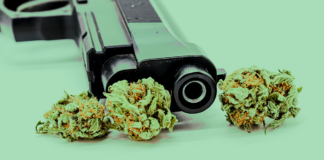
In recent years, many cannabis users have turned to the sleekness of the vape pen, and there’s little mystery about why: vaporizers are seen as a discreet, less socially invasive way to consume weed. They’re also perceived as a healthier choice when compared with the lung-polluting effects of bongs, joints, and bowls.
But—and we hate to be the bearers of bad news—while vaping technology may reduce the inhalation of pyrolytic smoke compounds, that doesn’t mean that your Kandypen is entirely without risk. A study published by JAMA Network Open suggests that vaporizing cannabis can lead to more immediate deleterious side effects and physical impairment, as compared to puffing the same amount of herb from a joint.
The study was based on the reactions of 17 adults, all of whom averaged 27 years of age and qualified as infrequent smokers who haven’t used cannabis in over a year. So, take the following results with a grain of salt. Participants consumed varying quantities of marijuana in both vapor and smoke forms over three separate eight-and-a-half hour sessions. Then, the subjects answered a questionnaire that delved into the drug’s subjective effects. They also performed tests that measured their cognitive, psychomotor, and cardiovascular responses. Those being observed in the study were monitored to determine THC concentration in their bloodstream after consuming.
Overall, researchers found more intense highs were reported when people vaped. Among the subjective symptoms that seemed to increase after vaping were dry mouth, irritated eyes, anxiety, having an “unpleasant” sensation, memory impairment, and—perhaps most surprisingly—throat irritation and coughing. Additionally, when participants took the highest dose, 25 mg, more people reported feelings of paranoia when they vaped. Via both methods of consumption, most symptoms peaked within the first hour after using the plant.
Vaping 25 mg was also more likely to cause impaired cognitive and psychomotor ability versus smoking the equivalent amount. The study’s blood tests also suggested that after consuming larger doses, THC concentration in the blood was higher when the cannabis had been vaped.
A key thing to remember is that when you vape cannabis, fewer cannabinoids are lost to the combustion that occurs when smoking a joint or bowl. That means you need to keep an eye on how you’re feeling because the potential to get lit-as-hell while vaping is much more pronounced. Another important thing to consider is that we still don’t have a lot of information on the long-term effects of vaping (that fact mirrors the current dearth of scientific research on cannabis in general.)
Growing concern over the rise of the vaporizer has a lot to do with its nicotine uses, and the effect it may be having on younger generations. Recent studies show that vaping has become increasingly popular among middle and high schoolers. Younger people’s proclivity for flavored vape products has led the FDA to propose regulation that would severely limit the availability of such items. Realistically, it’s not just nicotine, though. We imagine the younger generations will also be well acquainted with vaping cannabis than older generations ever were.











